正反译法及其原则
- 格式:doc
- 大小:16.00 KB
- 文档页数:3
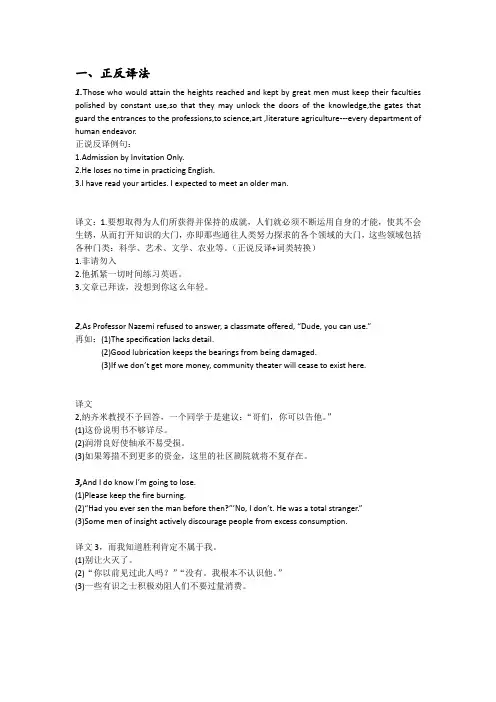
一、正反译法1.T hose who would attain the heights reached and kept by great men must keep their faculties polished by constant use,so that they may unlock the doors of the knowledge,the gates that guard the entrances to the professions,to science,art ,literature agriculture---every department of human endeavor.正说反译例句:1.Admission by Invitation Only.2.He loses no time in practicing English.3.I have read your articles. I expected to meet an older man.译文:1.要想取得为人们所获得并保持的成就,人们就必须不断运用自身的才能,使其不会生锈,从而打开知识的大门,亦即那些通往人类努力探求的各个领域的大门,这些领域包括各种门类:科学、艺术、文学、农业等。
(正说反译+词类转换)1.非请勿入2.他抓紧一切时间练习英语。
3.文章已拜读,没想到你这么年轻。
2,As Professor Nazemi refused to answer, a classmate offered, “Dude, you can use.”再如:(1)The specification lacks detail.(2)Good lubrication keeps the bearings from being damaged.(3)If we don’t get more money, community theater will cease to exist here.译文2,纳齐米教授不予回答,一个同学于是建议:“哥们,你可以告他。
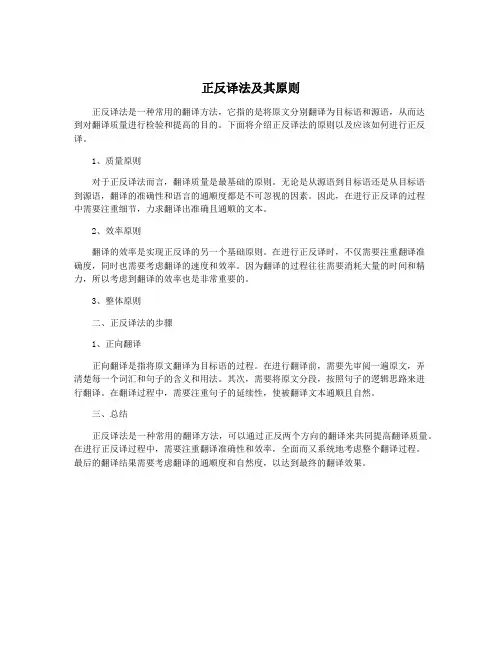
正反译法及其原则
正反译法是一种常用的翻译方法,它指的是将原文分别翻译为目标语和源语,从而达
到对翻译质量进行检验和提高的目的。
下面将介绍正反译法的原则以及应该如何进行正反译。
1、质量原则
对于正反译法而言,翻译质量是最基础的原则。
无论是从源语到目标语还是从目标语
到源语,翻译的准确性和语言的通顺度都是不可忽视的因素。
因此,在进行正反译的过程
中需要注重细节,力求翻译出准确且通顺的文本。
2、效率原则
翻译的效率是实现正反译的另一个基础原则。
在进行正反译时,不仅需要注重翻译准
确度,同时也需要考虑翻译的速度和效率。
因为翻译的过程往往需要消耗大量的时间和精力,所以考虑到翻译的效率也是非常重要的。
3、整体原则
二、正反译法的步骤
1、正向翻译
正向翻译是指将原文翻译为目标语的过程。
在进行翻译前,需要先审阅一遍原文,弄
清楚每一个词汇和句子的含义和用法。
其次,需要将原文分段,按照句子的逻辑思路来进
行翻译。
在翻译过程中,需要注重句子的延续性,使被翻译文本通顺且自然。
三、总结
正反译法是一种常用的翻译方法,可以通过正反两个方向的翻译来共同提高翻译质量。
在进行正反译过程中,需要注重翻译准确性和效率,全面而又系统地考虑整个翻译过程。
最后的翻译结果需要考虑翻译的通顺度和自然度,以达到最终的翻译效果。
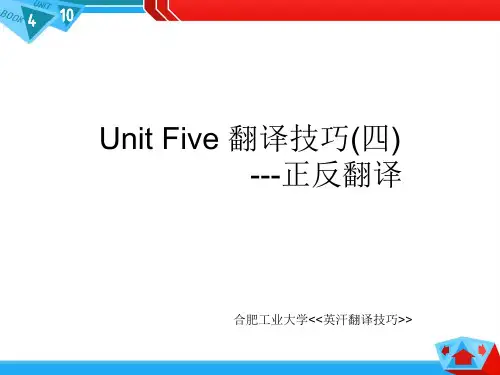

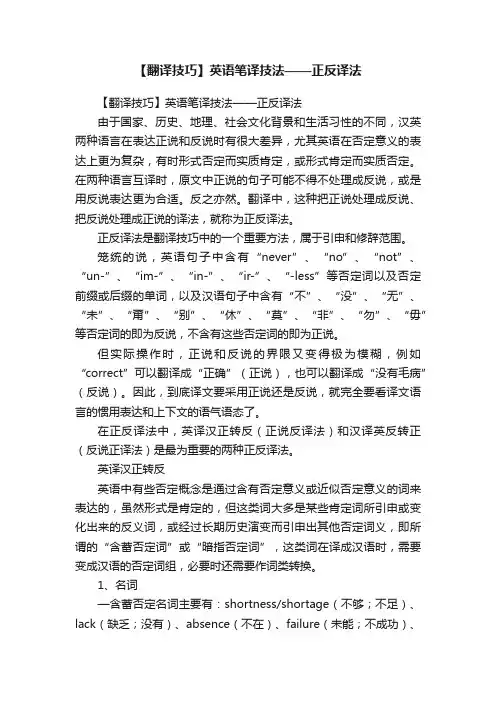
【翻译技巧】英语笔译技法——正反译法【翻译技巧】英语笔译技法——正反译法由于国家、历史、地理、社会文化背景和生活习性的不同,汉英两种语言在表达正说和反说时有很大差异,尤其英语在否定意义的表达上更为复杂,有时形式否定而实质肯定,或形式肯定而实质否定。
在两种语言互译时,原文中正说的句子可能不得不处理成反说,或是用反说表达更为合适。
反之亦然。
翻译中,这种把正说处理成反说、把反说处理成正说的译法,就称为正反译法。
正反译法是翻译技巧中的一个重要方法,属于引申和修辞范围。
笼统的说,英语句子中含有“never”、“no”、“not”、“un-”、“im-”、“in-”、“ir-”、“-l ess”等否定词以及否定前缀或后缀的单词,以及汉语句子中含有“不”、“没”、“无”、“未”、“甭”、“别”、“休”、“莫”、“非”、“勿”、“毋”等否定词的即为反说,不含有这些否定词的即为正说。
但实际操作时,正说和反说的界限又变得极为模糊,例如“correct”可以翻译成“正确”(正说),也可以翻译成“没有毛病”(反说)。
因此,到底译文要采用正说还是反说,就完全要看译文语言的惯用表达和上下文的语气语态了。
在正反译法中,英译汉正转反(正说反译法)和汉译英反转正(反说正译法)是最为重要的两种正反译法。
英译汉正转反英语中有些否定概念是通过含有否定意义或近似否定意义的词来表达的,虽然形式是肯定的,但这类词大多是某些肯定词所引申或变化出来的反义词,或经过长期历史演变而引申出其他否定词义,即所谓的“含蓄否定词”或“暗指否定词”,这类词在译成汉语时,需要变成汉语的否定词组,必要时还需要作词类转换。
1、名词—含蓄否定名词主要有:shortness/shortage(不够;不足)、lack(缺乏;没有)、absence(不在)、failure(未能;不成功)、defiance(不顾;无视)、denial(否认;否定)、exclusion(排除)、freedom(不;免除)、refusal(不愿;不允许)、loss(失去)等。
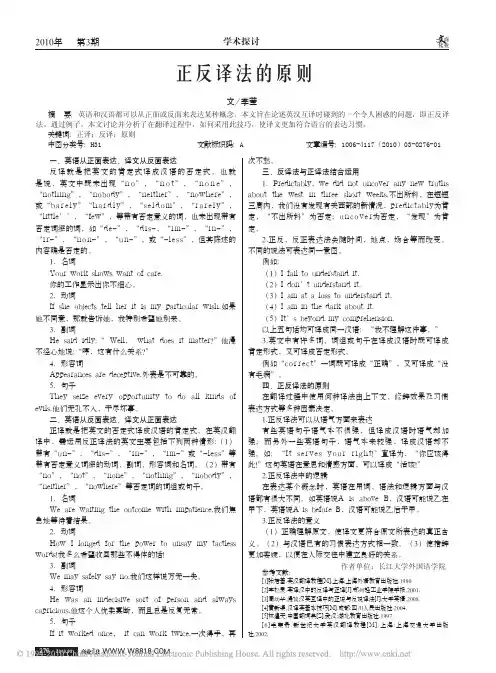
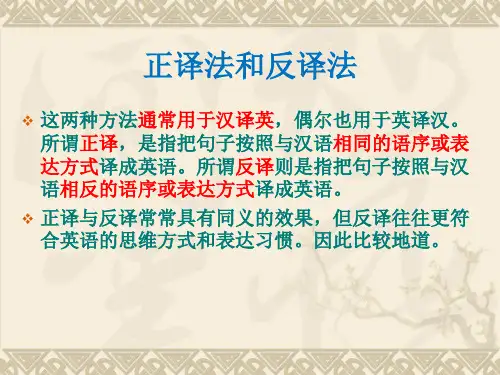
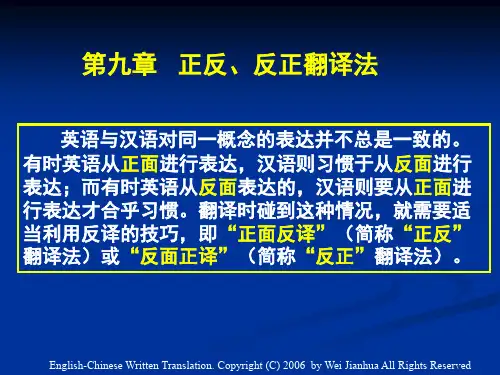
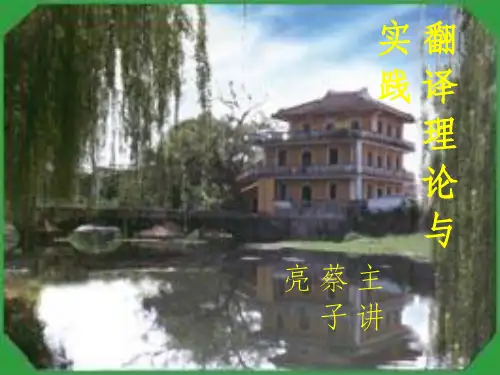


正反译法及其原则作者:唐志高来源:《海峡科学》2011年第10期[摘要] 英语和汉语都可以从正面或反面来表达某个概念,该文旨在论述英汉互译时一个棘手的问题,即正反译法。
文章结合实例讨论并分析了在翻译过程中,如何运用正反译法以使译文更加符合语言的表达习惯。
[关键词] 正译反译原则1 英语从正面表达,译文从反面表达反译就是把英语的肯定式翻译成汉语的否定式。
也就是说,英文中既未出现“no”, “not”, “none”, “nothing”, “nobody”, “neither”, “nowhere”或”barely”, “hardly”, “seldom”, “rarely”, “little”, “few”等含有否定意义的词,也未出现带有否定词缀的词,如“de-”, “dis-”, “in-”, “im-”, “un-”, “ir-”, “non-”或“-less”等,但其陈述的内容却是否定的。
1.1名词。
The interview shows his lack of experience.这次面试表明他经验不足。
1.2 动词。
We are greatly surprised that she rejected our proposal.她不接受我们的提议,这让我们很是惊讶。
1.3 形容词。
The reasoning is ridiculous.这样推断不合常理。
1.4 副词。
He is standing under the tree quietly.他一声不吭的站在树下。
1.5 句子。
He did all kinds of evils in the past.过去的日子里,他无恶不作。
2 英语从反面表达,汉语从正面表达正译就是把英语的否定式翻译成汉语的肯定式。
翻译时,需用到反正译法的英文主要有以下两种情形:(1)带有“de-”, “dis-”, “in-”, “im-”, “un-”, “ir-”, “non-”或“-less”等表示否定意义的词缀的名词、动词、副词和形容词;(2)带有“no”, “not”, “none”, “nothing”, “nobody”, “neither”, “nowhere”或”barely”, “hardly”, “seldom”, “rarely”, “little”, “few”等表示否定意义的词、词组或句子。
正反译法及其原则
正反译法又称双向翻译法,是指将一种语言的原文翻译成另一种语言的译文,再将该译文翻译回原文,以比较两次翻译的差异,从而改进翻译质量的方法。
正反译法有以下几个原则:
1. 完整性原则。
译文应当完整、准确地反映原文意义,不得有任何遗漏或添加。
2. 通顺性原则。
译文应当流畅、通顺,符合目标语言的语言习惯和表达习惯。
3. 等效性原则。
译文应当尽可能地保持与原文相同的含义和风格,同时满足目标语言的翻译要求。
4. 文化适应性原则。
译文应当考虑到目标语言的文化背景和社会环境,以确保译文的可接受性和可理解性。
正反译法能够有效地提高翻译质量,但也存在一定的局限性。
例如,对于某些语言特征或文化差异较大的内容,正反译法可能无法完全满足翻译要求,需要其他翻译方法的配合。
因此,在翻译过程中,需要根据具体情况选择不同的翻译方法,以达到最佳翻译效果。
- 1 -。
正反译法及其原则
作者:唐志高
来源:《海峡科学》2011年第10期
[摘要] 英语和汉语都可以从正面或反面来表达某个概念,该文旨在论述英汉互译时一个棘手的问题,即正反译法。
文章结合实例讨论并分析了在翻译过程中,如何运用正反译法以使译文更加符合语言的表达习惯。
[关键词] 正译反译原则
1 英语从正面表达,译文从反面表达
反译就是把英语的肯定式翻译成汉语的否定式。
也就是说,英文中既未出现“no”, “not”, “none”, “nothing”, “nobody”, “neither”, “nowhere”或”barely”, “hardly”, “seldom”, “rarely”, “little”, “few”等含有否定意义的词,也未出现带有否定词缀的词,如“de-”, “dis-”, “in-”, “im-”, “un-”, “ir-”, “non-”或“-less”等,但其陈述的内容却是否定的。
1.1名词。
The interview shows his lack of experience.这次面试表明他经验不足。
1.2 动词。
We are greatly surprised that she rejected our proposal.她不接受我们的提议,这让我们很是惊讶。
1.3 形容词。
The reasoning is ridiculous.这样推断不合常理。
1.4 副词。
He is standing under the tree quietly.他一声不吭的站在树下。
1.5 句子。
He did all kinds of evils in the past.过去的日子里,他无恶不作。
2 英语从反面表达,汉语从正面表达
正译就是把英语的否定式翻译成汉语的肯定式。
翻译时,需用到反正译法的英文主要有以下两种情形:(1)带有“de-”, “dis-”, “in-”, “im-”, “un-”, “ir-”, “non-”或“-less”等表示否定意义的词缀的名词、动词、副词和形容词;(2)带有“no”, “not”, “none”, “nothing”, “nobody”, “neither”, “nowhere”或”barely”, “hardly”, “seldom”, “rarely”, “little”, “few”等表示否定意义的词、词组或句子。
2.1名词。
He left with nothing in hands.他离开时,两手空空。
2.2动词。
He wished to undo the foolish deeds.他但愿能收回做的那些蠢事。
2.3形容词。
He is very unlucky in the exam.这次考试他很倒霉。
2.4副词。
They argued with each other groundlessly.他们的辩论缺乏依据。
2.5句子。
He who has never been drunk does not know how strong a wine is.醉过方知酒浓。
3 反译法与正译法结合运用
3.1同时使用。
Presumably, the mysterious ancient tomb has been be unveiled.不出所料,这座古墓终于揭开了它的神秘面纱。
这里,“presumably”被反译为“不出所料”,“uncovered”被正译为“揭开面纱”,正译法和反译法在一个句子里实现了结合。
3.2 正译法和反译法可视具体情况而定
例如:
(1) I didn’t understand it.
(2) I failed to understand it.
(3) I was at a loss about it.
(4) I was in the dark about it.
(5) It was beyond my comprehension.
这五句均可译为:我没理解这件事。
3.3英文中许多词和短语既可译成肯定式,也可译成否定式
例如:wrong既可译成“错误”,也可译成“不对”。
又如:out of order既可译成“次序颠倒”,也可译成“不讲顺序”。
4 正反译法的原则
翻译过程中究竟运用正译法还是反译法,应视语气、习惯表达法、修辞效果和逻辑等具体情况而定。
4.1 视语气而定。
有时,原文的语气不是很强,译文需要通过正译法或反译法来加强语气;也有时,原文的语气较强,译文需要通过正译法或反译法来舒缓语气。
例如:A sings as well as B. 甲唱歌丝毫不亚于乙。
又如:A is no better than B. 甲乙半斤八两。
4.2 视表达习惯而定。
例如:A is second to none. 甲最棒(甲第一)。
4.3 视修辞效果而定。
例如:She has been a widow for only six months. 她的丈夫死了不到半年。
不宜译成“她才守了六个月的寡。
”虽然“守寡”与“死了丈夫”是同一含义,但在两种译文中的修辞效果却大相径庭。
4.4 视逻辑而定。
例如:Everything should not go beyond a certain limit. 凡事物极必反。
“超出极限”即是“走向反面”,这是同一逻辑,是同一个问题的两个方面,没有中间状态,即它们是非此即彼的关系,这是运用正反译法一个最基本的原则。
5 正反译法的意义
基于以上译例和原则,不难看出,灵活、恰当地运用正反译法可以使译文更加地道,更加流畅,也更加富于表达力,和原文达到异曲同工之妙。
参考文献:
[1] 周幼华. 漫谈汉英互译中的正说与反说译法[J]. 大学英语,2008(2): 39-42.
[2] 陈生保. 英汉翻译津指[M]. 北京: 中国对外翻译出版公司,2000.。